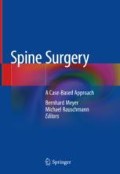Abstract
Adjacent segment degeneration (ASD) is defined as radiographic degenerative changes at a spinal level immediately cranial or caudal to the site of a previous fusion procedure. ASD can progress to adjacent segment disease a clinical phenomenon characterized by the presentation of new symptoms referable to the adjacent level, presumably related to the degenerative changes. The presented case should illustrate potential failure sources and indication as well as treatment management.
Access this chapter
Tax calculation will be finalised at checkout
Purchases are for personal use only
References
Radcliff KE, et al. Adjacent segment disease in the lumbar spine following different treatment interventions. Spine J. 2013;13(10):1339–49.
Abode-Iyamah K, et al. Spinal motion and intradiscal pressure measurements before and after lumbar spine instrumentation with titanium or PEEK rods. J Clin Neurosci. 2014;21(4):651–5.
Lee CS, et al. Risk factors for adjacent segment disease after lumbar fusion. Eur Spine J. 2009;18(11):1637–43.
Kraemer P, et al. A systematic review of definitions and classification systems of adjacent segment pathology. Spine (Phila Pa 1976). 2012;37(22 Suppl):S31–9.
Harrop JS, et al. Lumbar adjacent segment degeneration and disease after arthrodesis and total disc arthroplasty. Spine (Phila Pa 1976). 2008;33(15):1701–7.
Hilibrand AS, et al. Radiculopathy and myelopathy at segments adjacent to the site of a previous anterior cervical arthrodesis. J Bone Joint Surg Am. 1999;81(4):519–28.
Ghiselli G, et al. Adjacent segment degeneration in the lumbar spine. J Bone Joint Surg Am. 2004;86-A(7):1497–503.
Sears WR, et al. Incidence and prevalence of surgery at segments adjacent to a previous posterior lumbar arthrodesis. Spine J. 2011;11(1):11–20.
Rothenfluh DA, et al. Pelvic incidence-lumbar lordosis mismatch predisposes to adjacent segment disease after lumbar spinal fusion. Eur Spine J. 2015;24(6):1251–8.
Park JS, et al. Risk-factor analysis of adjacent segment disease requiring surgery after short lumbar fusion: the influence of rheumatoid arthritis. Spine J. 2018;18(9):1578–83.
Author information
Authors and Affiliations
Corresponding author
Editor information
Editors and Affiliations
Rights and permissions
Copyright information
© 2019 Springer Nature Switzerland AG
About this chapter
Cite this chapter
Franke, J., Michalitsis, S. (2019). Adjacent Segment Disease with 13 Years Follow Up and Five Operations. In: Meyer, B., Rauschmann, M. (eds) Spine Surgery. Springer, Cham. https://doi.org/10.1007/978-3-319-98875-7_74
Download citation
DOI: https://doi.org/10.1007/978-3-319-98875-7_74
Published:
Publisher Name: Springer, Cham
Print ISBN: 978-3-319-98874-0
Online ISBN: 978-3-319-98875-7
eBook Packages: MedicineMedicine (R0)

